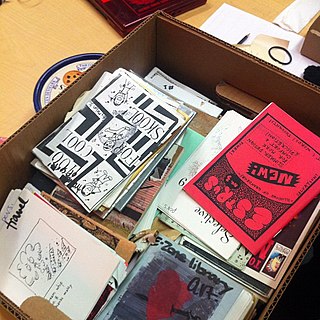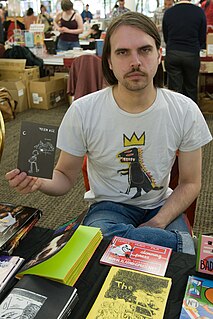Related Research Articles
A fanzine is a non-professional and non-official publication produced by enthusiasts of a particular cultural phenomenon for the pleasure of others who share their interest. The term was coined in an October 1940 science fiction fanzine by Russ Chauvenet and first popularized within science fiction fandom, and from there it was adopted by other communities.

A zine is a small-circulation self-published work of original or appropriated texts and images, usually reproduced via a copy machine. Zines are the product of either a single person or of a very small group, and are popularly photocopied into physical prints for circulation. A fanzine is a non-professional and non-official publication produced by enthusiasts of a particular cultural phenomenon for the pleasure of others who share their interest. The term was coined in an October 1940 science fiction fanzine by Russ Chauvenet and popularized within science fiction fandom, entering the Oxford English Dictionary in 1949.

Factsheet Five was a periodical mostly consisting of short reviews of privately produced printed matter along with contact details of the editors and publishers.

A science-fiction fanzine is an amateur or semi-professional magazine published by members of science-fiction fandom, from the 1930s to the present day. They were one of the earliest forms of fanzine, within one of which the term "fanzine" was coined, and at one time constituted the primary type of science-fictional fannish activity ("fanac").
A minicomic is a creator-published comic book, often photocopied and stapled or with a handmade binding. In the United Kingdom and Europe the term small press comic is equivalent with minicomic, reserved for those publications measuring A6 or less.
An amateur press association (APA) is a group of people who produce individual pages or zines that are sent to a Central Mailer for collation and distribution to all members of the group.
British small press comics, once known as stripzines, are comic books self-published by amateur cartoonists and comic book creators, usually in short print runs, in the UK. They're comparable to similar movements internationally, such as American minicomics and Japanese doujinshi. A "small press comic" is essentially a zine composed predominantly of comic strips. The term emerged in the early 1980s to distinguish them from zines about comics. Notable artists who have had their start in British small press comics include Eddie Campbell, Paul Grist, Rian Hughes, Jamie Hewlett, Alan Martin, Philip Bond and Andi Watson.
Slab-O-Concrete Productions was a British mail order distributor and publisher, founded by Peter Pavement, Dave Hanna, Emma Copsey, and Chris Tappenden; operating mostly in Brighton and Hove during the 1990s. Initially selling British small press comics and zines, Slab-O-Concrete also imported publications from the United States, Australia, and Europe.
Carl Gafford is a colorist who has worked for several decades in the comics industry. His career has spanned several publishers, including Marvel Comics, DC Comics and Topps Comics.
The Grand Comics Database (GCD) is an Internet-based project to build a database of comic book information through user contributions. The GCD project is cataloging information on creator credits, story details, reprints, and other information useful to the comic book reader, comic collector, fan, and scholar. The GCD is a 501(c)(3) nonprofit organization incorporated in Arkansas.
STAPLE! The Independent Media Expo is an annual convention in Austin, Texas, United States, for alternative comics, minicomics, webcomics, zines, underground comics, and graphic arts. Chris Nicholas founded the conference as a gathering place for professional artists and amateur creators, "a showcase for the folks who publish comics and zines and possible literary masterworks out of their own apartments."
Interlac is a bimonthly amateur press association devoted to the DC Comics science fiction superhero team the Legion of Super-Heroes. It was the first APA devoted to the Legion and, despite the decline of APAs due to Internet forums, continues to operate to this day. June 2021 marked the 45th anniversary.
CAPA-alpha was the first amateur press association (APA) devoted to comic books, started by Jerry Bails in the United States in 1964.

The Comic Reader (TCR) was a comics news-fanzine published from 1961 to 1984. Debuting in the pre-direct market era, TCR was the first regularly published comics industry news fanzine, and was able to secure many contacts from within the ranks of the larger publishers. As TCR increased in popularity and influence, it was able to attract professional artist to illustrate the covers. TCR also proved to be a launching pad for aspiring comic book creators, many of whom published work in the fanzine as amateurs. Contributors from the world of fandom included founding editor Jerry Bails, key editor Paul Levitz, Paul Kupperberg, Tony Isabella, Byron Preiss, Neal Pozner, Don Rosa, Carl Gafford, and Doug Hazlewood.

Timothy "Tim" Patrick Goodyear is an American minicomics publisher, distributor, and comics artist from San Jose, California. He has been a contributor to Tim Root's Crappy Comics, Sean Aaberg's PORK, and has compiled several collaborative zines.
The British Amateur Press Association was an amateur press association created by comics fans in late 1977, following a proposal from Phil Greenaway in the letter pages of the comics fanzine Bemusing; the first mailing was circulated in January 1978. Greenaway was the first Central Mailer and his successors included Maureen "Mo" James, Howard Stangroom, Les Chester, and Steve Green. For most of its existence, up to thirty members of BAPA submitted multiple copies of at least two A4 pages to the central mailer every two months. BAPA was disbanded on 17 August 2004 with a final mailing distributed early in 2005. A one-off publication was also distributed under the name B-APA (sic) in 2005, in memory of Andy Roberts; a similar publication was announced in 2008, in memory of Steve Whitaker.
The Comic and Fantasy Art Amateur Press Association (CFA-APA) was founded in 1985 by Roger Hill. Its membership consists of knowledgeable fans, creators, and collectors of comic and fantasy art who write about various subjects related to those genres. The group self-publishes approximately three times a year and each issue has a theme relating to a specific creator or subject. Currently, membership is limited to 40 persons at any one time and circulation is limited to 55 issues, making the publication itself highly collectible.

The Amazing World of DC Comics was DC Comics' self-produced fan magazine of the mid-1970s. Running 17 issues, the fanzine featured DC characters and their creators, and was exclusively available through mail order. Primarily text articles, with occasional strips and comics features, Amazing World offered a great deal of insight into Bronze Age DC corporate and creative culture.

Cartoonists Co-op Press was an underground comix publishing cooperative based in San Francisco that operated from 1973 to 1974. It was a self-publishing venture by cartoonists Kim Deitch, Bill Griffith, Jerry Lane, Jay Lynch, Willy Murphy, Diane Noomin, and Art Spiegelman. Cartoonist Justin Green's brother Keith acted as salesman/distributor, and the operation was run out of Griffith's apartment.
References
- ↑ Rhode Island Comic Creators Announce Assembly. New England Small Press Assembly. 17 Oct. 2009.